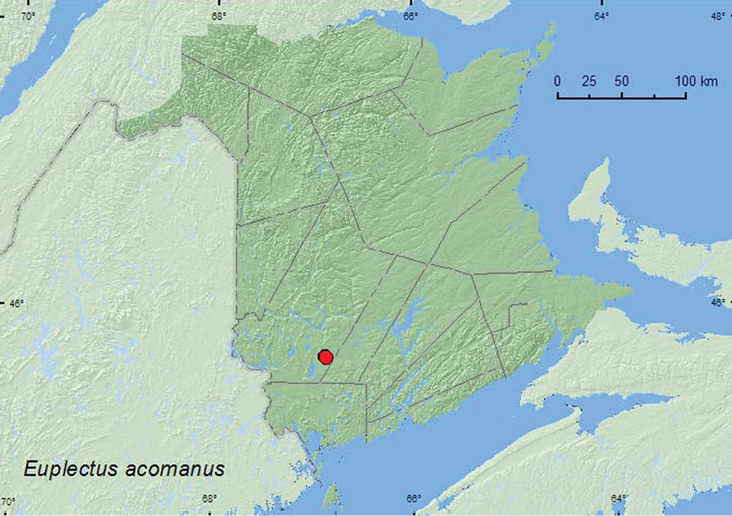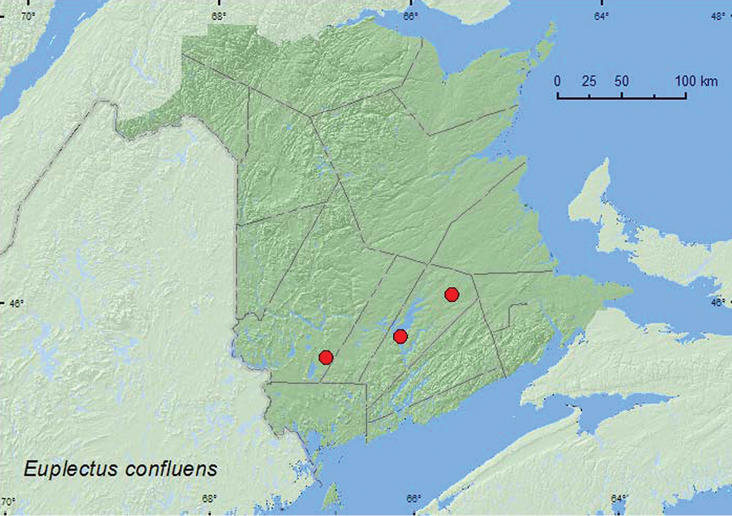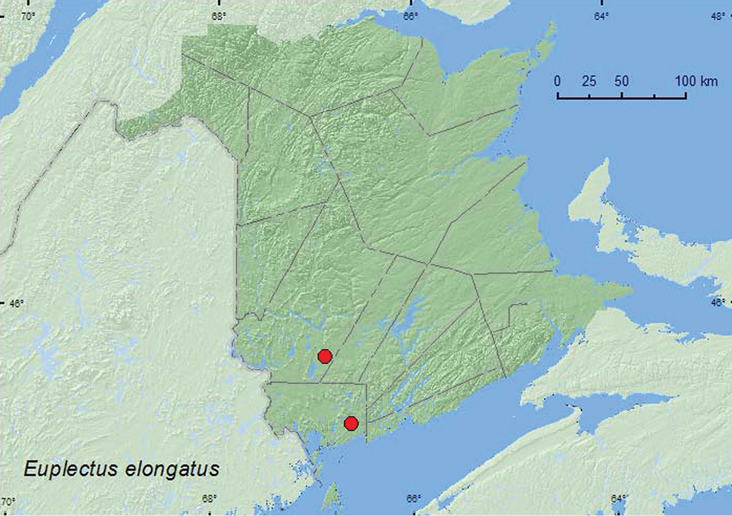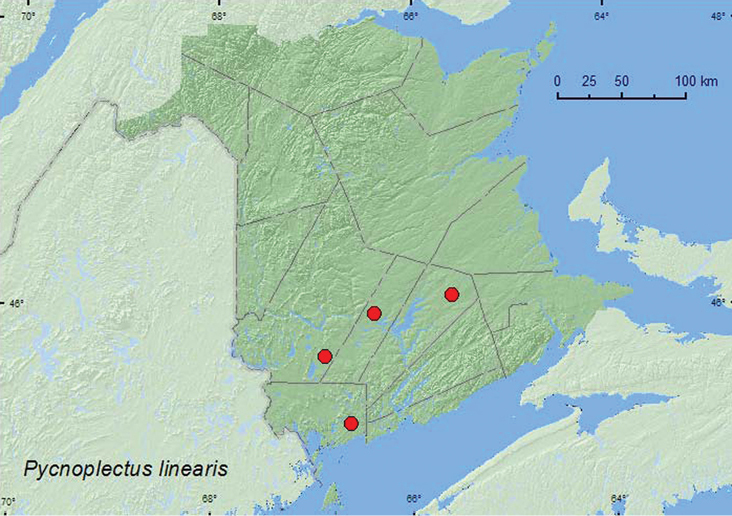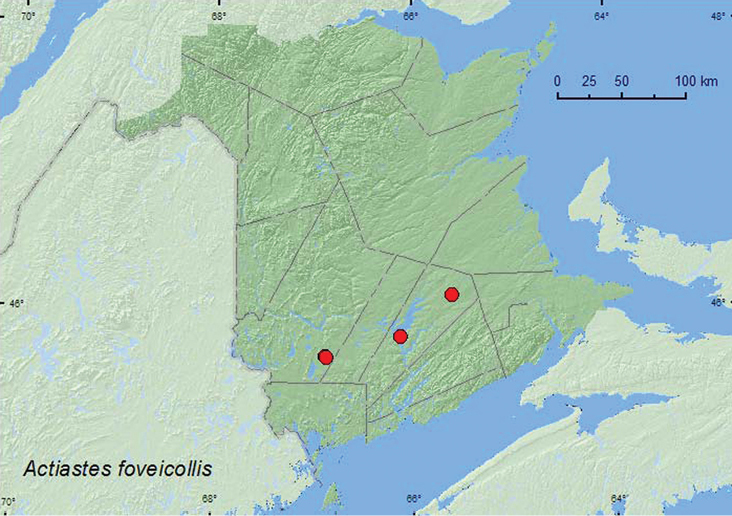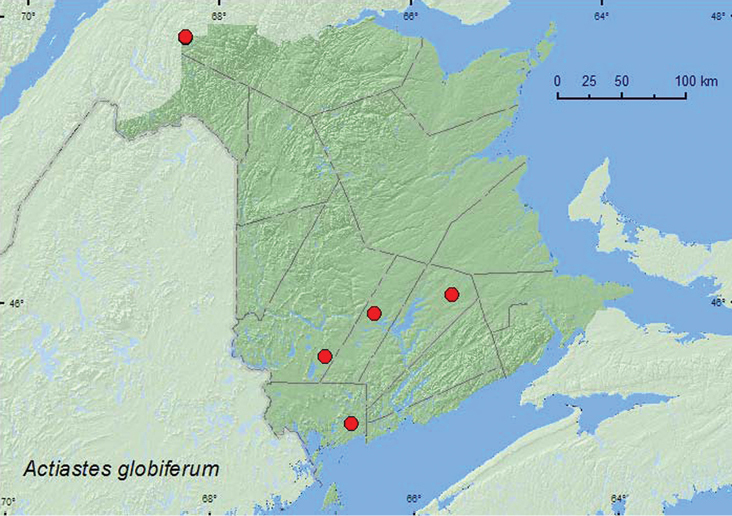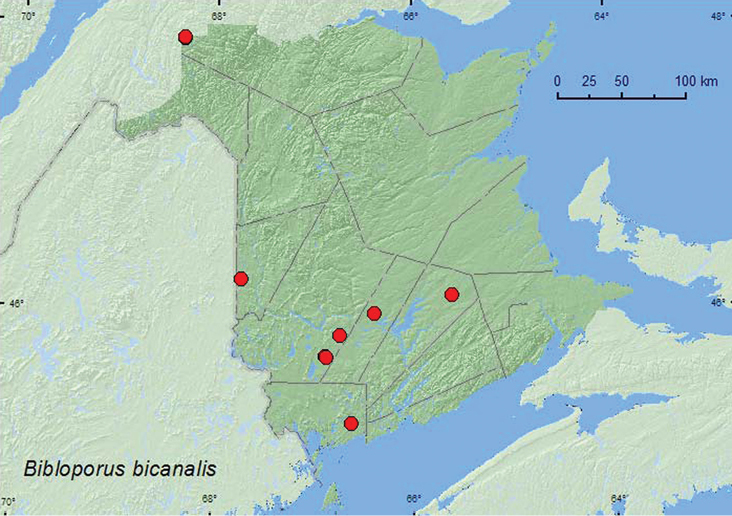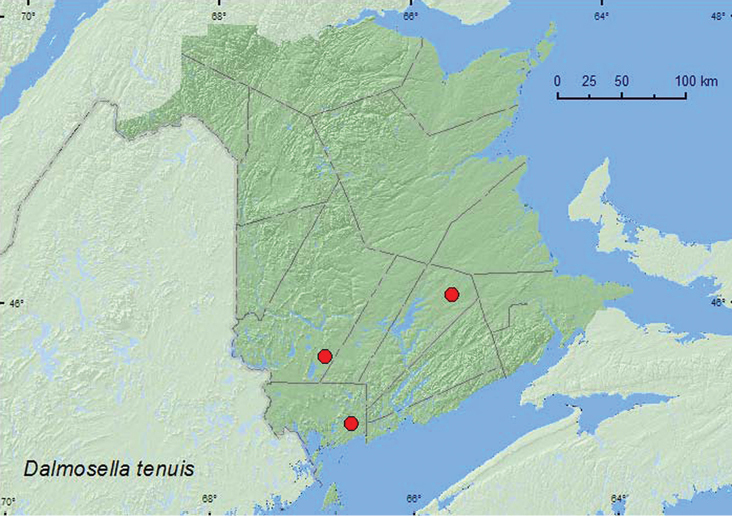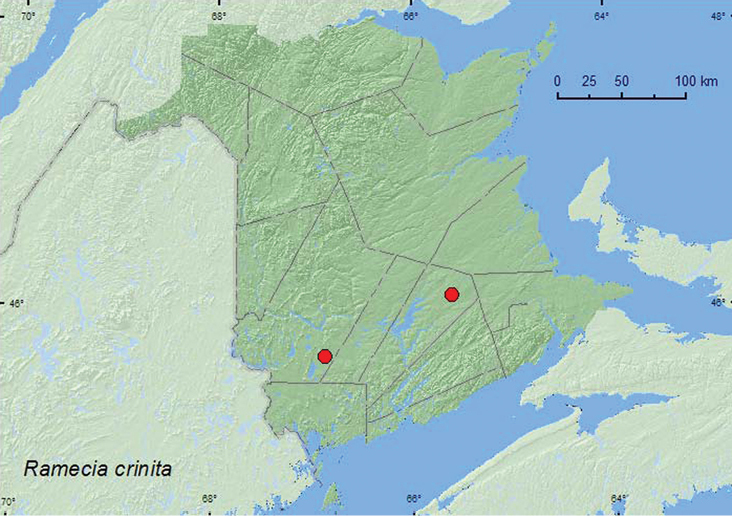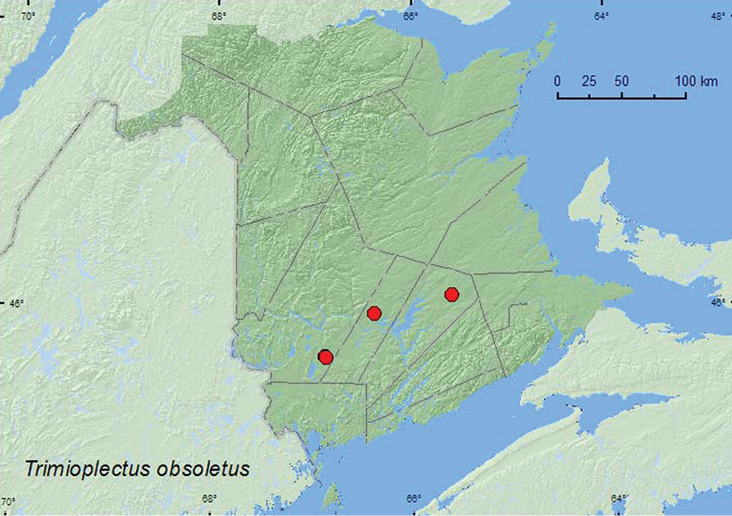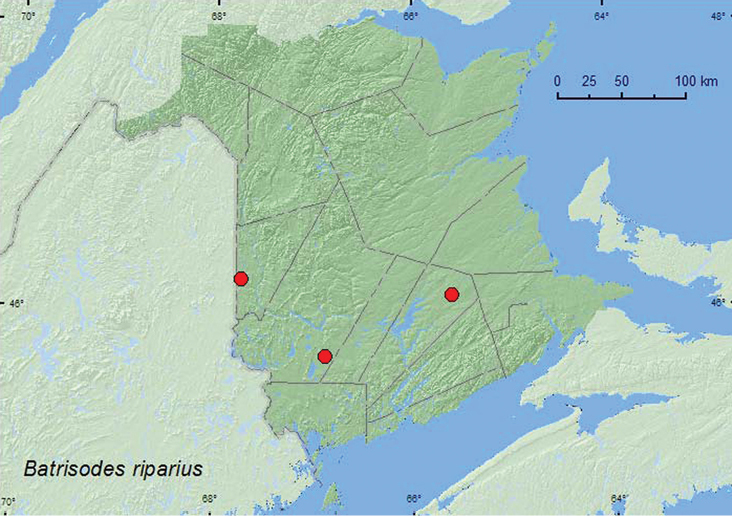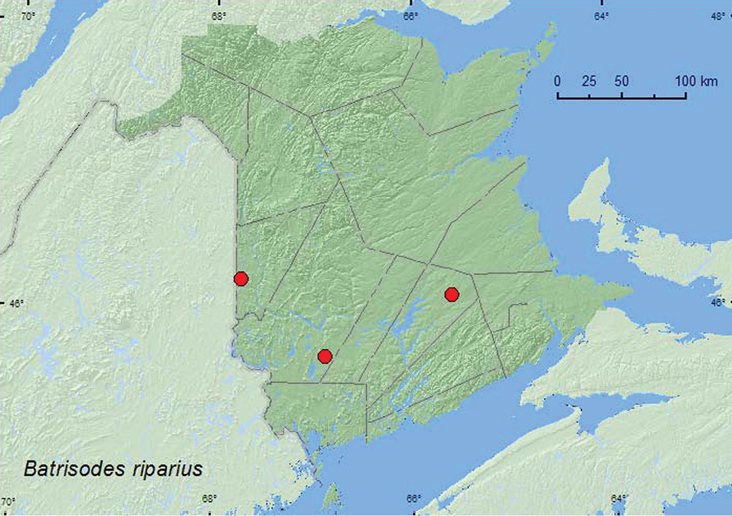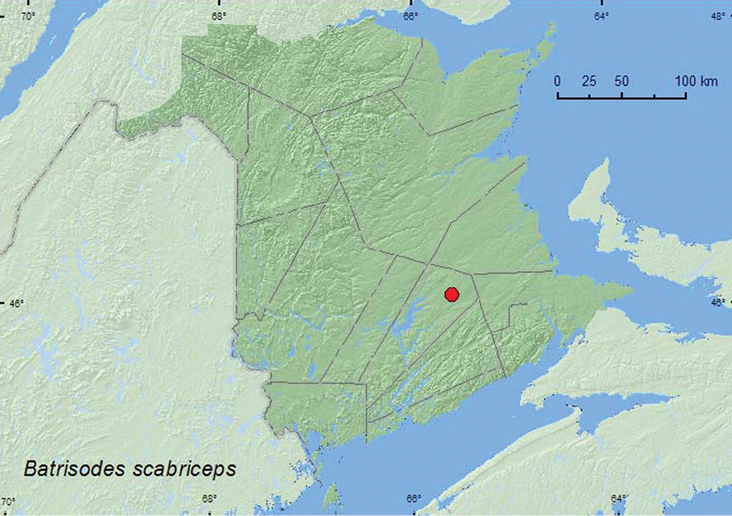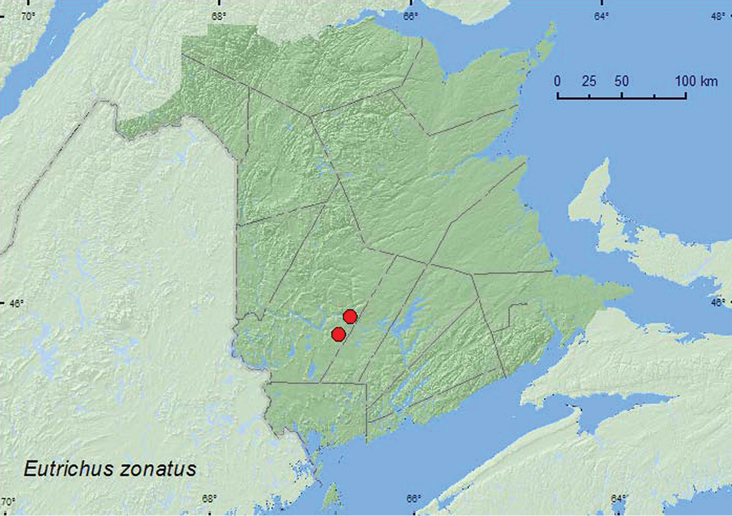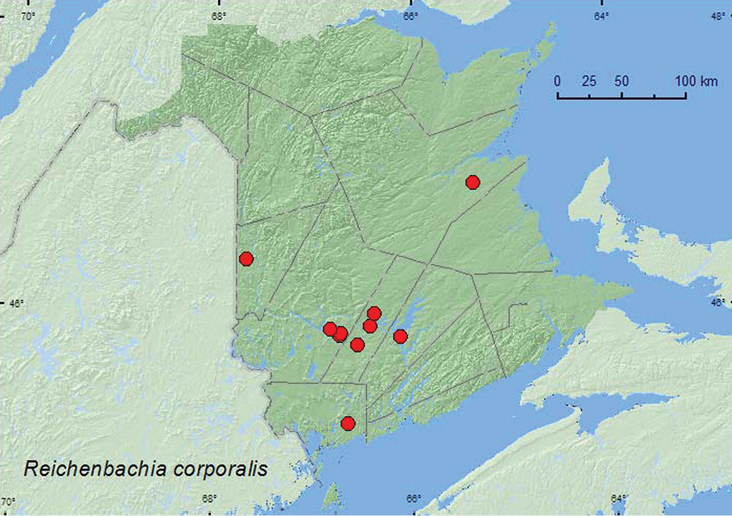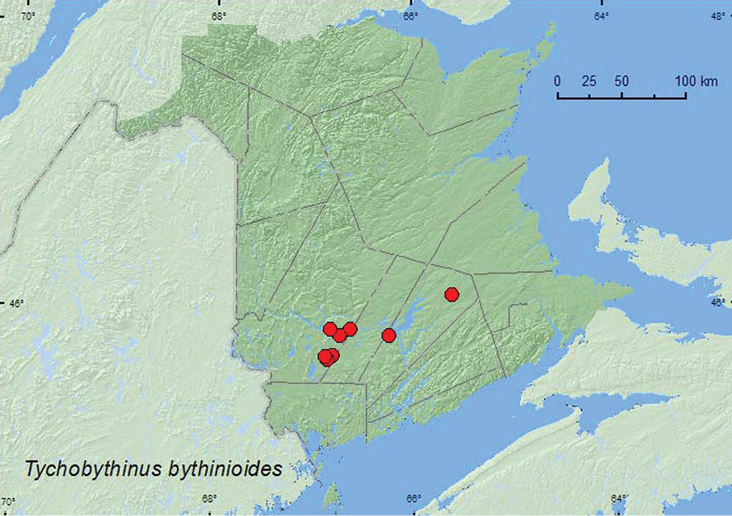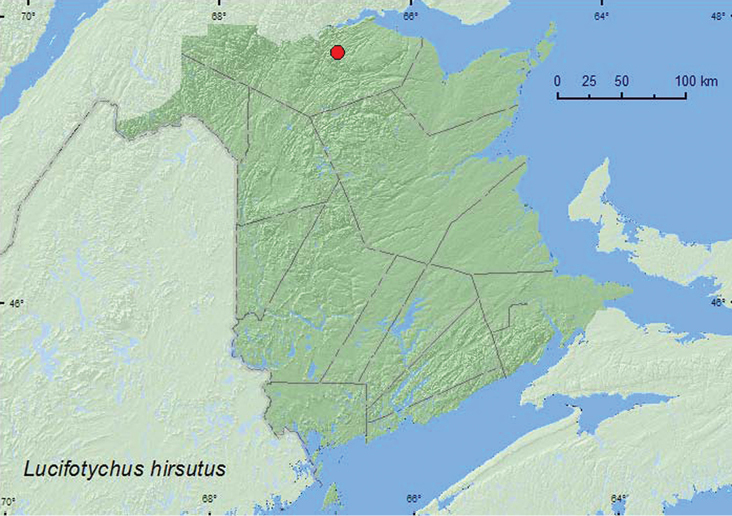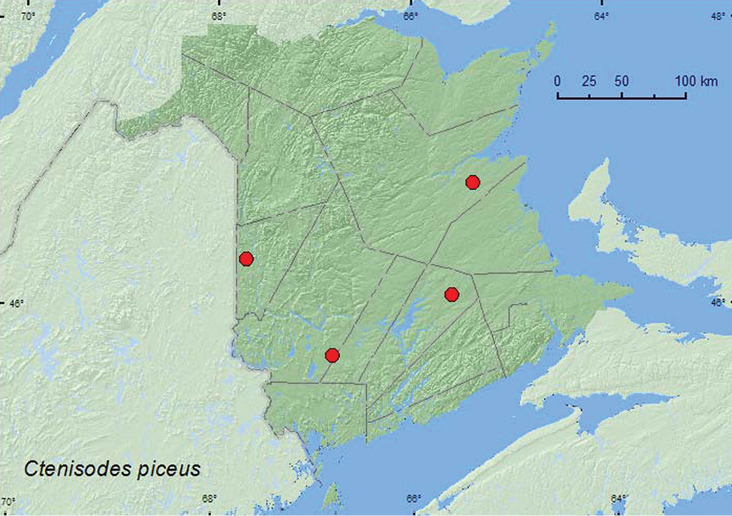






(C) 2012 Reginald P. Webster. This is an open access article distributed under the terms of the Creative Commons Attribution License 3.0 (CC-BY), which permits unrestricted use, distribution, and reproduction in any medium, provided the original author and source are credited.
For reference, use of the paginated PDF or printed version of this article is recommended.
Twenty species of Pselaphinae are newly recorded from New Brunswick, Canada. This brings the total number of species known from the province to 36. Thirteen of these species are newly recorded for the Maritime provinces of Canada. Dalmosella tenuis Casey and Brachygluta luniger (LeConte) are newly recorded for Canada. Collection and habitat data are presented for these species.
Staphylinidae, Pselaphinae, new records, Canada, New Brunswick
This paper treats new Staphylinidae records from New Brunswick from the subfamily Pselaphinae. Taxonomically, the North American species of Pselaphinae are fairly well known. Most species in the Maritime provinces (New Brunswick, Nova Scotia, Prince Edward Island) of eastern Canada can be determined using keys and descriptions in
Species of Pselaphinae from eastern Canada are found in moss, grass, and leaf litter in marshes, bogs, and along stream margins, the intertidal zone of salt marshes, forest floor litter, in rotten logs, under bark of dead trees and logs, in tree holes, and in ant nests (
Over 710 species of Pselaphinae are known from North America (
The following records are based on specimens collected during a general survey by the first author to document the Coleoptera fauna of New Brunswick, and from the by-catch of samples obtained during a study to develop a general attractant for the detection of invasive species of Cerambycidae.
Collection methodsVarious collection methods were employed to collect the species reported in this study. Details are outlined in
Males of Actiastes, Euplectus, and Pycnoplectus were dissected in order to confirm their identity. The genital structures were dehydrated in absolute alcohol and either mounted in Canada balsam on celluloid microslides and pinned with the specimens from which they originated, or glued onto points with the specimens.
DistributionDistribution maps, created using ArcMap and ArcGIS, are presented for each species in New Brunswick. Every species treated has its currently known distribution in Canada and Alaska indicated, using standard two-letter abbreviations for the states, provinces, and territories. New records for New Brunswick are indicated in bold under Distribution, which covers Canada and Alaska. The following abbreviations are used in the text:
| AK | Alaska | MB | Manitoba |
| YT | Yukon Territory | ON | Ontario |
| NT | Northwest Territories | QC | Quebec |
| NU | Nunavut | NB | New Brunswick |
| BC | British Columbia | PE | Prince Edward Island |
| AB | Alberta | NS | Nova Scotia |
| SK | Saskatchewan | NF & LB | Newfoundland and Labrador |
Acronyms of collections examined or where specimens referred to in this study reside are as follows:
AFC Atlantic Forestry Centre, Natural Resources Canada, Canadian Forest Service, Fredericton, New Brunswick, Canada
CNC Canadian National Collection of Insects, Arachnids and Nematodes, Agriculture and Agri-Food Canada, Ottawa, Ontario, Canada
NBM New Brunswick Museum, Saint John, New Brunswick, Canada
RWC Reginald P. Webster Collection, Charters Settlement, New Brunswick, Canada
ResultsTwenty species of Pselaphinae are newly recorded from New Brunswick. This brings the total number of species known from the province to 36. Thirteen of these species are newly recorded for the Maritime provinces of Canada. Two are newly recorded for Canada.
Species accountsAll records below are species newly recorded for New Brunswick, Canada. Species followed by ** are newly recorded from the Maritime provinces of Canada. A list of species of Pselaphinae currently known from New Brunswick is given in Table 1.
Species of Pselaphinae (Staphylinidae) recorded from New Brunswick, Canada.
| Subfamily Pselaphinae Latreille |
| Supertribe Euplectitae Streubel |
| Tribe Euplectini Streubel |
| Actiastes foveicollis (LeConte)** |
| Actiastes globiferum (LeConte)** |
| Bibloplectus integer (LeConte) |
| Bibloporus bicanalis (Casey)* |
| Dalmosella tenuis Casey*** |
| Euplectus acomanus Casey** |
| Euplectus confluens LeConte** |
| Euplectus duryi Casey |
| Euplectus elongatus Brendel* |
| Pycnoplectus linearis (LeConte)* |
| Ramecia crinita (Brendel)* |
| Trimioplectus obsoletus Brendel** |
| Supertribe Batrisitae Reitter |
| Tribe Batrisini Reitter |
| Batrisodes frontalis (LeConte)** |
| Batrisodes lineaticollis (Aubé) |
| Batrisodes riparius (Say)** |
| Batrisdoes scabriceps (LeConte)** |
| Supertribe Goniaceritae Reitter |
| Tribe Brachyglutini Raffray |
| Brachygluta abdominalis (Aubé) |
| Brachygluta luniger (LeConte)*** |
| Decarthron abnorme (LeConte)* |
| Eutrichites zonatus (Brendel)** |
| Reichenbachia borealis Casey |
| Reichenbachia corporalis Casey** |
| Reichenbachia propinqua (LeConte) |
| Reichenbachia spatulifer Casey |
| Rybaxis clavata (Brendel) |
| Rybaxis conjuncta (LeConte) |
| Rybaxis mystica Casey |
| Rybaxis transversa Fall |
| Rybaxis varicornis (Brendel) |
| Tribe Bythinini Raffray |
| Tychobythinus bythinioides (Brendel)* |
| Tribe Tychini Raffray |
| Lucifotychus hirsutus Chandler* |
| Lucifotychus testaceus (Casey) |
| Supertribe Pselaphitae Latreille |
| Tribe Tyrini Reitter |
| Tyrus semiruber Casey |
| Tribe Ctenistini Blanchard |
| Ctenisodes piceus (LeConte)** |
| Tribe Pselaphini Latreille |
| Pselaphus bellax Casey |
| Pselaphus fustifer Casey |
Notes: *New to province; **New to Maritime provinces; ***New to Canada.
The classification of the Pselaphinae follows the classification of
Subfamily Pselaphinae Latreille, 1802
Supertribe Euplectitae Streubel, 1839
Tribe Euplectini Streubel, 1839
New Brunswick, York Co., 15 km W of Tracy off Rt. 645, 45.6848°N, 66.8821°W, 20–29.VII.2009, 4–11.VIII.2009, R. Webster & M.-A. Giguère, old red pine forest, Lindgren funnel traps (2 ♂, RWC); same locality and forest type, 4–16.VI.2010, 16–30.VI.2010, R. Webster & C. MacKay, Lindgren funnel traps (2 ♂, RWC); same locality and forest type, 30.VI.–13.VII.2010, R. Webster & K. Burgess (2 ♂, RWC); 14 km WSW of Tracy, S of Rt. 645, 45.6741°N, 66.8661°W, 30.VI-13.VII.2010, R. Webster & K. Burgess, old mixed forest with red and white spruce, red and white pine, balsam fir, eastern white cedar, red maple, and Populus sp., Lindgren funnel traps (1 ♂, RWC).
Collection localities in New Brunswick, Canada of Euplectus acomanus.
QC, NB (
New Brunswick, Queens Co., Cranberry Lake P.N.A, 46.1125°N, 65.6075°W, 25.VI–1.VII.2009, 10–15.VII.2009, 15–21.VII.2009, 28.VII-6.VIII.2009, R. Webster & M.-A. Giguère, old red oak forest, Lindgren funnel traps (8 ♂, AFC, RWC); Grand Lake Meadows P.N.A., 45.8227°N, 66.1209°W, 31.V-15.VI.2010, R. Webster & C. MacKay, old silver maple forest with green ash and seasonally flooded marsh, Lindgren funnel trap (1 ♂, RWC). York Co., 14 km WSW of Tracy, S of Rt. 645, 45.6741°N, 66.8661°W, 30.VI–13.VII.2010, R. Webster & K. Burgess, old mixed forest with red and white spruce, red and white pine, balsam fir, eastern white cedar, red maple, and Populus sp., Lindgren funnel trap (1 ♂, RWC).
Collection localities in New Brunswick, Canada of Euplectus confluens.
QC, NB (
New Brunswick, Charlotte Co., 10 km NW of New River Beach, 45.2110°N, 66.6170°W, 29.VI-16.VII.2009, R. Webster & C. MacKay, old growth eastern white cedar forest, Lindgren funnel trap (1 ♂, RWC). York Co., 15 km W of Tracy off Rt. 645, 45.6848°N, 66.8821°W, 4–11.V.2009, 11–19.V.2009, R. Webster & M.-A. Giguère, old red pine forest, Lindgren funnel traps (4 ♂, RWC); same locality and forest type, 18.V-2.VI.2010, R. Webster & C. MacKay, Lindgren funnel traps (2 ♂, RWC); same locality and forest type, 27.VII-10.VIII.2010, R. Webster & C. Hughs (1 ♂, RWC).
Collection localities in New Brunswick, Canada of Euplectus elongatus.
Euplectus elongatus has been found in leaf litter and under bark of a decaying log (
ON, QC, NB, NS (
New Brunswick, Charlotte Co., 10 km NW of New River Beach, 45.2110°N, 66.6170°W, 10–23.VIII.2010, C. Hughes & K. Burgess, old growth eastern white cedar forest, Lindgren funnel trap (1 ♂, RWC). Queens Co., Cranberry Lake P.N.A, 46.1125°N, 65.6075°W, 18–25.VI.2009, 25.VI-1.VII.2009, 1–10.VII.2009, 10–15.VII.2009, R. Webster & M.-A. Giguère, old red oak forest, Lindgren funnel traps (4 ♂, AFC, RWC). Sunbury Co., Acadia Research Forest, 45.9866°N, 66.3841°W, 8–13.V.2009, 21–29.VII.2009, R. Webster & M.-A. Giguère, red spruce forest with red maple and balsam fir, Lindgren funnel traps (2, RWC). York Co., 15 km W of Tracy off Rt. 645, 45.6848°N, 66.8821°W, 7–14.VII.2009, 21–29.VII.2009, R. Webster & M.-A. Giguère, old red pine forest, Lindgren funnel traps (2 ♂, RWC); same locality and forest type, 10–26.V.2010, 4–16.VI.2010, R. Webster & C. MacKay, Lindgren funnel traps (2 ♂, RWC).
Collection localities in New Brunswick, Canada of Pycnoplectus linearis.
This species has been collected from log mold, sawdust, tree holes, and under bark (
ON, NB, NS (
New Brunswick, Queens Co., Cranberry Lake P.N.A, 46.1125°N, 65.6075°W, 11–18.VI.2009, 28.VII-6.VIII.2009, 6–14.VIII.2009, R. Webster & M.-A. Giguère, old red oak forest, Lindgren funnel traps (3, RWC); Grand Lake Meadows P.N.A., 45.8227°N, 66.1209°W, 12–26.VII.2010, R. Webster & C. MacKay, old silver maple forest with green ash and seasonally flooded marsh, Lindgren funnel trap (1, RWC). York Co., 15 km W of Tracy off Rt. 645, 45.6848°N, 66.8821°W, 15–21.VI.2009, 7–14.VII.2009, 11–18.VIII.2009, R. Webster & M.-A. Giguère, old red pine forest, Lindgren funnel traps (4, AFC, RWC); same locality and forest type, 16–30.VI.2010, R. Webster & C. MacKay, Lindgren funnel traps (2, RWC); 14 km WSW of Tracy, S of Rt. 645, 45.6741°N, 66.8661°W, 26.IV–10.V.2010, 16–30.VI.2010, 30.VI–13.VII.2009, R. Webster & C. MacKay, old mixed forest with red and white spruce, red and white pine, balsam fir, eastern white cedar, red maple, and Populus sp., Lindgren funnel traps (4, AFC, RWC).
Collection localities in New Brunswick, Canada of Actiastes foveicollis.
This species was collected from leaf litter in New Hampshire (
BC, ON, QC, NB (
New Brunswick, Charlotte Co., 10 km NW of New River Beach, 45.2110°N, 66.6170°W, 29.VI-16.VII.2009, 16–26.VII.2010, R. Webster & C. MacKay, old growth eastern white cedar forest, Lindgren funnel traps (2, AFC). Queens Co., Cranberry Lake P.N.A, 46.1125°N, 65.6075°W, 27.V–5.VI.2009, 11–18.VI.2009, 25.VI-1.VII.2009, 1–10.VII.2009, 10–15.VII.2009, 15–21.VII.2009, R. Webster & M.-A. Giguère, old red oak forest, Lindgren funnel traps (10, AFC, NBM, RWC). Restigouche Co., Dionne Brook P.N.A., 47.9030°N, 68.3503°W, 27.VI–14.VII.2011, 28.VII-9.VIII.2011, M. Roy & V. Webster, old-growth northern hardwood forest, Lindgren funnel traps (2, AFC, NBM); same locality and collectors but 47.9064°N, 68.3441°W, 27.VI-14.VII.2011, 14–28.VII.2011, 28.VII–9.VIII.2011, old-growth white spruce and balsam fir forest, Lindgren funnel traps (5, NBM, RWC). Sunbury Co., Acadia Research Forest, 45.9866°N, 66.3841°W, 13–21.VII.2009, R. Webster & M.-A. Giguère, red spruce forest with red maple and balsam fir, Lindgren funnel trap (1, AFC). York Co., 15 km W of Tracy off Rt. 645, 45.6848°N, 66.8821°W, 19–25.V.2009, 1–8.VI.2009, 8–15.VI.2009, 15–21.VI.2009, 21–28.VI.2009, 28.VI–7.VII.2009, 20–29.VII.2009, R. Webster & M.-A. Giguère, old red pine forest, Lindgren funnel traps (9, AFC, RWC).
Collection localities in New Brunswick, Canada of Actiastes globiferum.
QC, NB (
New Brunswick, Carleton Co., Jackson Falls, Bell Forest, 46.2200°N, 67.7231°W, 4–12.VI.2008, 19–27.VI.2008, 27.VI-5.VII.2008, 5–12.VII.2008, R. P. Webster, mature hardwood forest, Lindgren funnel traps (6, AFC, NBM, RWC); same locality and forest type, 23–28.IV.2009, 28.IV–9.V.2009, 9–14.V.2009, 14–20.V.2009, 20–26.V.2009, 26.V–1.VI.2009, 1–8.VI.2009, R. Webster & M.-A. Giguère, Lindgren funnel traps (16, AFC, RWC). Charlotte Co., 10 km NW of New River Beach, 45.2110°N, 66.6170°W, 17–31.V.2010, R. Webster & C. MacKay, old growth eastern white cedar forest, Lindgren funnel trap (1, AFC). Queens Co., Cranberry Lake P.N.A (Protected Natural Area), 46.1125°N, 65.6075°W, 24.IV–5.V.2009, 5–12.V.2009, 12–21.V.2009, 21–27.V.2009, 5–11.VI.2009, 11–18.VI.2009, R. Webster & M.-A. Giguère, old red oak forest, Lindgren funnel traps (9, AFC, RWC). Restigouche Co., Dionne Brook P.N.A., 47.9030°N, 68.3503°W, 30.V–15.VI.2011, M. Roy & V. Webster, old-growth northern hardwood forest, Lindgren funnel traps (2, AFC, NBM); same locality and collectors but 47.9064°N, 68.3441°W, 31.V–15.VI.2011, old-growth white spruce and balsam fir forest, Lindgren funnel trap (1, NBM). Sunbury Co., Acadia Research Forest, 45.9866°N, 66.3841°W, 2–9.VI.2009, 16–24.VI.2009, 24–30.VI.2009, R. Webster & M.-A. Giguère, red spruce forest with red maple and balsam fir (110 years-old), Lindgren funnel traps (5, AFC). York Co., 15 km W of Tracy off Rt. 645, 45.6848°N, 66.8821°W, 25.IV–4.V.2009, 4–11.V.2009, 11–19.V.2009, 1–8.VI.2009, 8–15.VI.2009, 15–21.VI.2009, R. Webster & M.-A. Giguère, old red pine forest, Lindgren funnel traps (8, AFC, RWC); 14 km WSW of Tracy, S of Rt. 645, 45.6741°N, 66.8661°W, 26.IV–10.V.2010, 10–26.V.2010, R. Webster & C. MacKay, old mixed forest with red and white spruce, red and white pine, balsam fir, eastern white cedar, red maple, and Populus sp., Lindgren funnel traps (4, AFC, RWC); Charters Settlement, 45.8288°N, 66.7365°W, 1–11.IX.2008, R. P. Webster, mature mixed forest, Lindgren funnel trap (1, RWC).
Collection localities in New Brunswick, Canada of Bibloporus bicanalis.
Bibloporus bicanalis was reported from white pine litter (
QC, NB, NS(
CANADA, New Brunswick, Charlotte Co., 10 km NW of New River Beach, 45.2110°N, 66.6170°W, 29.VI-16.VII.2010, R. Webster & C. MacKay, old eastern white cedar forest, Lindgren funnel trap (1, AFC). Queens Co., Cranberry Lake P.N.A, 46.1125°N, 65.6075°W, 18–25.VI.2009, 14–19.VIII.2009, R. Webster & M.-A. Giguère, old red oak forest, Lindgren funnel traps (2, RWC): same locality data and forest type, 7–13.VII.2011, M. Roy & V. Webster, Lindgren funnel trap (1, RWC). York Co., 15 km W of Tracy off Rt. 645, 45.6848°N, 66.8821°W, 21–28.VI.2009, 4–11.VIII.2009, R. Webster & M.-A. Giguère, old red pine forest, Lindgren funnel traps (2, RWC); same locality and forest type, 30.VI-13.VII.2010, R. Webster & K. Burgess, Lindgren funnel trap (1, RWC).
Collection localities in New Brunswick, Canada of Dalmosella tenuis.
NB (new Canadian record).
New Brunswick, Queens Co., Cranberry Lake P.N.A, 46.1125°N, 65.6075°W, 21–27.V.2009, 5–11.VI.2009, 18–25.VI.2009, 25.VI–1.VII.2009, R. Webster & M.-A. Giguère, old red oak forest, Lindgren funnel traps (4, AFC, RWC); same locality data and forest type, 13–25.V.2011, 25.V–7.VI.2011, 7–22.VI.2011, M. Roy & V. Webster, Lindgren funnel traps (4, NBM, RWC). York Co., 15 km W of Tracy off Rt. 645, 45.6848°N, 66.8821°W, 15–21.VI.2009, R. Webster & M.-A. Giguère, old red pine forest, Lindgren funnel traps (5, RWC); same locality and forest type, 4–16.VI.2010, 16–30.VI.2010, R. Webster & C. MacKay, Lindgren funnel traps (2, RWC).
Collection localities in New Brunswick, Canada of Ramecia crinita.
This species has been found under bark of maple and oak (
QC, NB, NS (
New Brunswick, Queens Co., Cranberry Lake P.N.A, 46.1125°N, 65.6075°W, 11–18.VI.2009, 18–25.VI.2009, 25.VI-1.VII.2009, 15–21.VII.2009, 21–28.VII.2009, R. Webster & M.-A. Giguère, old red oak forest, Lindgren funnel traps (9, AFC, RWC). Sunbury Co., Acadia Research Forest, 45.9866°N, 66.3841°W, 24–30.VI.2009, 30.VI-8.VII.2009, 8–13.VII.2009, 13–21.VII.2009, R. Webster & M.-A. Giguère, red spruce forest with red maple and balsam fir, Lindgren funnel traps (8, AFC, RWC). York Co., 15 km W of Tracy off Rt. 645, 45.6848°N, 66.8821°W, 15–21.VI.2009, 20–29.VII.2009, R. Webster & M.-A. Giguère, old red pine forest, Lindgren funnel traps (3, AFC, RWC); 14 km WSW of Tracy, S of Rt. 645, 45.6741°N, 66.8661°W, 10–26.V.2010, R. Webster & C. MacKay, old mixed forest with red and white spruce, red and white pine, balsam fir, eastern white cedar, red maple, and Populus sp., Lindgren funnel traps (2, AFC).
Collection localities in New Brunswick, Canada of Trimioplectus obsoletus.
ON, QC, NB (
Tribe Batrisini Reitter, 1882
New Brunswick, Carleton Co., Jackson Falls, Bell Forest, 46.2200°N, 67.7231°W, 5–12.VII.2008, R. P. Webster, mature hardwood forest, Lindgren funnel trap (1, RWC). Queens Co., Cranberry Lake P.N.A, 46.1125°N, 65.6075°W, 31.V–11.VI.2009, 11–18.VI.2009, 25.VI-1.VII.2009, 15–21.VII.2009, 28.VII-6.VIII.2009, R. Webster & M.-A. Giguère, old red oak forest, Lindgren funnel traps (6, AFC, NBM, RWC); Grand Lake Meadows P.N.A., 45.8227°N, 66.1209°W, 12–26.VII.2010, R. Webster & C. MacKay, old silver maple forest with green ash and seasonally flooded marsh, Lindgren funnel trap (1, RWC). Sunbury Co., Acadia Research Forest, 45.9866°N, 66.3841°W, 13–21.VII.2009, 21–29.VII.2009, R. Webster & M.-A. Giguère, red spruce forest with red maple and balsam fir, Lindgren funnel traps (2, RWC). York Co., 15 km W of Tracy off Rt. 645, 45.6848°N, 66.8821°W, 17–26.VII.2008, R. P. Webster, old red pine forest, Lindgren funnel trap (1, AFC); same locality and forest type but 21–28.VI.2009, 28.VI–7.VII.2009, R. Webster & M.-A. Giguère, Lindgren funnel traps (3, RWC).
Collection localities in New Brunswick, Canada of Batrisodes frontalis.
Batrisodesspeciesare usually found in leaf litter, rotten wood on the forest floor, or in ant nests amongst the ants, particularly beneath the bark of conifers (
AB, MB, ON, QC, NB (
New Brunswick, Carleton Co., Jackson Falls, Bell Forest, 46.2200°N, 67.7231°W, 5–12.VII.2008, R. P. Webster, mature hardwood forest, Lindgren funnel trap (1, RWC). Queens Co., Cranberry Lake P.N.A, 46.1125°N, 65.6075°W, 10–15.VII.2009, R. Webster & M.-A. Giguère, old red oak forest, Lindgren funnel trap (1, RWC). York Co., 15 km W of Tracy off Rt. 645, 45.6848°N, 66.8821°W, 21–27.VIII.2008, 21–28.VI.2009, 14–20.VII.2009, 20–29.VII.2009, R. Webster & M.-A. Giguère, old red pine forest, Lindgren funnel traps (5, AFC, RWC); same locality data and forest type, 30.VI-13.VII.2010, R. Webster & K. Burgess, Lindgren funnel trap (1, RWC).
Collection localities in New Brunswick, Canada of Batrisodes riparius.
Batrisodes ripariuswas reported from an ant (Aphaenogaster) nest by
ON, QC, NB (
New Brunswick, Queens Co., Cranberry Lake P.N.A, 46.1125°N, 65.6075°W, 11–18.VI.2009, 18–25.VI.2009, 1–10.VII.2009, 10–15.VII.2009, 28.VII–6.VIII.2009, R. Webster & M.-A. Giguère, old red oak forest, Lindgren funnel traps (8, AFC, RWC).
Collection localities in New Brunswick, Canada of Batrisodes scabriceps.
Batrisodes scabricepswas reported from nests of Lasius, Formica, and Aphaenogaster species of ants (
ON, QC, NB (
Tribe Brachyglutini Raffray, 1904
New Brunswick, Gloucester Co., near Acadian Historical Village, 47.7873°N, 65.0797°W, 14.VIII.2005, R. P. Webster & G. Pohl, salt marsh, intertidal zone, on patches of bare clay at base of Spartina patens on upper margin of tidal stream (10, RWC).
Collection localities in New Brunswick, Canada of Brachygluta luniger.
Brachygluta luniger was collected in the intertidal zone of a salt marsh and is known to be associated with salt marshes (
NB (new Canadian record). This species has been reported from Massachusetts south to Florida in the United States (
New Brunswick, Albert Co., Shepody N.W.A., New Horton Section, 45.6940°N, 64.7000°W, 29.VI.2004, R. P. Webster, cattail marsh, treading (1, RWC). Carleton Co., Two Mile Brook Fen, 46.3619°N, 67.6733°W, 6.V.2005, M.-A. Giguère & R. P. Webster, old growth eastern white cedar swamp, in litter at base of cedar (1, RWC);trail to Two Mile Brook Fen, 46.3510°N, 67.6815°W, 6.V.2005, M.-A. Giguère & R. P. Webster, cattail and Carex marsh, in leaf litter on marsh margin (1, RWC). Charlotte Co., S of Little Pocologan River, 45.1537°N, 66.2669°W, 7.V.2007, R. P. Webster, black spruce and tamarack bog, in litter and moss (1, NBM). Madawaska Co., Loon Lake, 236 m elev., 47.7839°N, 68.3943°W, 21.VII.2010, R. P. Webster, boreal forest, small lake surrounded by sedges, treading sedges near Myrica bushes (1 ♂, NBM). Saint John Co., Chance Harbour off Rt. 790, 45.1374°N, 66.3633°W, 15.V.2006, R. P. Webster, raised peatland (with black spruce), treading saturated sphagnum (1, RWC). Sunbury Co., Acadia Research Forest, 46.0173°N, 66.3741°W, 18.VI.2007, R. P. Webster, 8.5 year-old regenerating mixed forest, in sphagnum and leaf litter at bottom of old tire depression (1, RWC). York Co., Charters Settlement, 45.8282°N, 66.7367°W, 9.IV.2005, 29.III.2006, R. P. Webster, Carex marsh, in leaf litter at base of trees and shrubs (4, NBM, RWC); same locality and collector but 45.8430°N, 66.7280°W, 29.IX.2004, small sedge marsh, in moist litter (1, RWC): same locality and collector but 45.8395°N, 66.7391°W, 17.VII.2004, 27.VI.2006, 25.VI.2009, mixed forest, u.v. light (6, NBM, RWC); Canterbury, Browns Mountain Fen, 45.8967°N, 67.6343°W, 2.V.2005, M.-A. Giguère & R. P. Webster, calcareous cedar fen, in moss and litter at base of tree (cedar) (1, RWC); 8.4 km W of Tracy off Rt. 645, 45.68217°N, 66.7894°W, 14.V.2008, R. P. Webster, wet alder swamp, in leaf and grass litter on hummocks (1, NBM).
Collection localities in New Brunswick, Canada of Decarthron abnorme.
In New Brunswick, this common species was collected in various wetland habitats. These included Carex marshes, Carex marsh with scattered cattails (Typha sp.), a cattail marsh, a black spruce (Picea mariana (Mill.) B.S.P.) and tamarack (Larix laricina (Du Roi) K. Koch) bog, a coastal raised peatland with black spruce, an old eastern white cedar swamp, a regenerating mixed forest, along a lake margin among Carex, and in a wet alder (Alnus sp.) swamp. Adults were sifted from moss and litter at bases of trees and marsh margins, sphagnum and leaf litter, and leaf and grass litter on hummocks (alder swamp). Other adults were collected by treading vegetation in cattail and Carex marshes, Carex near Myrica bushes on a lake margin, and a saturated sphagnum mat in bog. Some adults were collected at an ultraviolet light near a mixed forest. This species is most commonly taken from leaf litter along the margins of streams, ponds, and marshes, and from sphagnum moss (
NT, BC, AB, SK, MB, ON, QC, NB, NS (
New Brunswick, York Co., Fredericton, at Saint John River, 45.9588°N, 66.6254°W, 4.VII.2004, R. P. Webster, river margin, in drift material (mostly maple seeds) (1, RWC); Charters Settlement, 45.8395°N, 66.7391°W, 27.VI.2006, 25.VI.2009, R. P. Webster, mixed forest, u.v. light (5, RWC).
Collection localities in New Brunswick, Canada of Eutrichites zonatus.
One specimen was sifted from drift material consisting mostly of maple seeds along a river margin. Other adults were captured at an ultraviolet light deployed near a mixed forest. Members of this species have been taken from grass debris, old river drift, and in sawdust and can be commonly taken at lights in the United States (
ON, QC, NB (
New Brunswick, Carleton Co., Two Mile Brook Fen, 46.3619°N, 67.6733°W, 6.V.2005, M.-A. Giguère & R. P. Webster, old growth eastern white cedar swamp, in litter at base of cedar (1, RWC). Charlotte Co., ca. 9 km NW of New River, 45.2117°N, 66.6436°W, 13.VI.2008, R. P. Webster, eastern white cedar swamp, in sphagnum and grasses under alders (1, NBM). Northumberland Co., Goodfellow Brook P.N.A., 46.8943°N, 65.3796°W, 23.V.2007, R. P. Webster, old growth eastern white cedar swamp (many vernal pools), in litter, grasses and moss on hummocks near water (1, RWC). Queens Co., W of Jemseg at “Trout Creek”, 45.8227°N, 66.1240°W, 9.V.2004, 4.VI.2004, R. P. Webster, silver maple swamp, sifting litter at base of large tree (2, RWC). Sunbury Co., Portobello Creek N.W.A., Maugerville, 45.8992°N, 66.4248°W, 18.VI.2004, R. P. Webster, silver maple forest, u.v. light trap (1, RWC); Sunpoke Lake marsh, 45.7663°N, 66.5537°W, 11.IX.2005, R. P. Webster, seasonally flooded marsh, in moist litter under Myrica gale L. bushes (1, RWC); Acadia Research Forest, 45.9866°N, 66.3841°W, 2–9.VI.2009, R. Webster & M.-A. Giguère, red spruce forest with red maple and balsam fir, Lindgren funnel trap (1, AFC). York Co., Charters Settlement, 45.8282°N, 66.7367°W, 9.IV.2005, R. P. Webster, Carex marsh, in leaf litter at base of trees and shrubs (2, RWC); same locality and collector but 45.8428°N, 66.7235°W, 9.IX.2005, 1.IV.2006, mixed forest, in leaf litter and moss near small brook (2, RWC); Mazerolle Settlement, 45.8729°N, 66.8311°W, 9.IV.2006, R. P. Webster, stream margin, in leaf litter at base of northern (eastern) white cedar (3, NBM).
Collection localities in New Brunswick, Canada of Reichenbachia corporalis.
In New Brunswick, adults of this species were collected in old eastern white cedar swamps and forests, silver maple swamps, a red spruce forest, a mixed forest, a Carex marsh, and a seasonally flooded marsh. Adults were sifted from leaf and/or conifer litter at the bases of trees, from sphagnum and grasses under alders and on hummocks near vernal pond margins, in moist leaf litter under Myrica gale L. bushes, and from leaf litter and moss near brook margins. One adult was collected in an ultraviolet light trap and another from a Lindgren funnel trap. Members of this species have been taken from sphagnum moss and from leaf litter of an alder/birch (Betula sp.) mixture at the edge of a freshwater marsh (
MB, ON, QC, NB (
http://species-id.net/wiki/Tychobythinus_bythinioides
Map 18New Brunswick, Queens Co., Upper Gagetown, bog adjacent to Hwy 2, 45.8316°N, 66.2346°W, 3.IV.2006, R. P. Webster, tamarack bog, in sphagnum hummocks on bog margin (1, RWC); Cranberry Lake P.N.A, 46.1125°N, 65.6075°W, 18–25.VI.2009, R. Webster & M.-A. Giguère, old red oak forest, Lindgren funnel trap (1, AFC). York Co., New Maryland, off Hwy 2, E of Baker Brook, 45.8760°N, 66.6252°W, 26.IV.2005, R. P. Webster, old growth eastern white cedar swamp, in moss and litter at base of tree (1, RWC); Charters Settlement, 45.8267°N, 66.7343°W, 3.V.2006, R. P. Webster, Carex marsh, in litter and sphagnum (1, RWC); Mazerolle Settlement, 45.8729°N, 66.8311°W, 28.IV.2006, stream margin, in leaf litter at base of tree (1, RWC); 9 km W of Tracy off Rt. 645, 45.6889°N, 66.8002°W, 5.IV.2010, R. P. Webster, old beaver flowage, in grass litter on clay near small brook (1, RWC); 14 km WSW of Tracy, S of Rt. 645, 45.6603°N, 66.8607°W, 2.V.2010, R. P. Webster, black spruce bog, in sphagnum hummock with Carex and grasses (1, RWC); 15.5 km W of Tracy off Rt. 645, 45.6845°N, 66.8826°W, 10.V.2010, R. P. Webster, wet Carex marsh adjacent to old red pine forest, treading sphagnum (1, RWC).
Collection localities in New Brunswick, Canada of Tychobythinus bythinioides.
In New Brunswick, this species was collected from a variety of wetland types. These include a tamarack bog, a black spruce bog, an old eastern white cedar swamp, Carex marshes, and an old beaver (Castor canadensis Kuhl) flowage with grasses. Adults occurred in sphagnum hummocks in bogs, in moss and litter at bases of trees, in litter and sphagnum in marshes, and in grass litter near a brook in an old beaver flowage. One individual was captured in a Lindgren funnel trap deployed in an old red oak forest.
ON, QC, NB, NS (
New Brunswick, Restigouche Co., Berry Brook Protected Area (P.N.A.), 47.8140°N, 66.7578°W, 26.V.2007, R. P. Webster, old growth eastern white cedar swamp, in moss & leaf litter under alders (1, RWC).
Collection localities in New Brunswick, Canada of Lucifotychus hirsutus.
The single adult from New Brunswick was collected in moss and leaf litter under alders in an old-growth eastern white cedar swamp during May.
MB, QC, NB, NS, NF (
Tribe Ctenistini Blanchard, 1845
New Brunswick, Carleton Co., Two Mile Brook Fen, 46.3619°N, 67.6733°W, 5.VIII.2004, 6.V.2005, M.-A. Giguère, R. P. Webster, & J. Edsall, old growth eastern white cedar swamp, in litter at base of cedar (2, RWC). Northumberland Co., Goodfellow Brook P.N.A., 46.8943°N, 65.3796°W, 23.V.2007, R. P. Webster, old growth eastern white cedar swamp (many vernal pools), in litter, grasses and moss on hummocks near water (2, RWC). Queens Co., Cranberry Lake P.N.A, 46.1125°N, 65.6075°W, 28.VII–6.VIII.2009, R. Webster & M.-A. Giguère, old red oak forest, Lindgren funnel trap (1, RWC). York Co., 9 km W of Tracy off Rt. 645, 45.6889°N, 66.8002°W, 5.IV.2010, R. P. Webster, old beaver flowage, in grass litter on clay near small brook (1, RWC).
Collection localities in New Brunswick, Canada of Ctenisodes piceus.
In New Brunswick, Ctenisodes piceus was collected in old eastern white cedar swamps, an old red oak forest, and in an old beaver flowage. Adults were sifted from litter at the base of a cedar, from a mix of litter, grasses, and moss on hummocks (in eastern white cedar swamp), and from grass litter near a small brook. One adult was captured in a Lindgren funnel trap.
ON, QC, NB (
We thank Caroline Simpson for editing this manuscript. Anthony Davies (CNC) and an anonymous reviewer are thanked for reviewing this manuscript. We thank Nichole Brawn, Katie Burgess, Stephen Clayden, Marie-Andrée Giguère, Jim Edsall, Nancy Harn, Cory Hughes, Rob Johns, Marsell Laity, Colin MacKay, Wayne MacKay, Jessica Price, Michelle Roy, and Vincent Webster for technical assistance and collecting specimens. Natural Resources Canada Canadian Forest Service; the Canadian Food Inspection Agency; and the USDA APHIS are thanked for funding the study on early detection of invasive cerambycids that provided the many specimens collected in Lindgren funnel traps. The New Brunswick Environmental Trust Fund and New Brunswick Wildlife Trust Fund are thanked for funding various insect surveys over the past 7 years, and the Meduxnekeag River Association is thanked for permission to sample beetles at the Meduxnekeag Valley Nature Preserve (which includes the Bell Forest). The Canadian Wildlife Service is thanked for funding insect surveys at the Portobello Creek National Wildlife Area. The New Brunswick Department of Natural Resources (Fish and Wildlife Branch) is thanked for issuing permits for sampling in the Protected Natural Areas and for providing logistical support.
